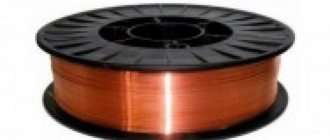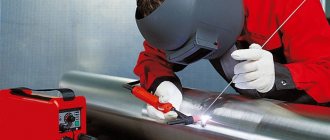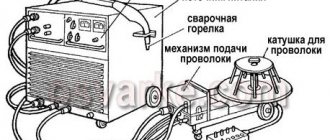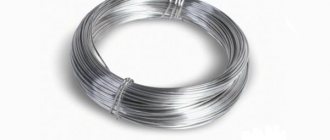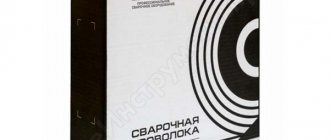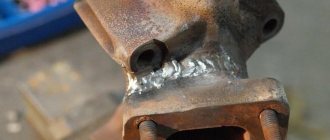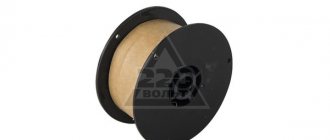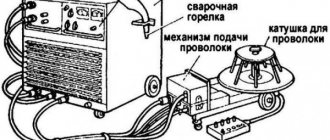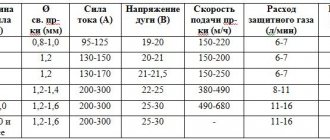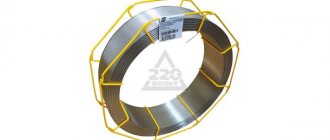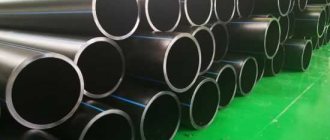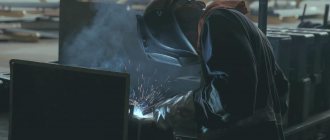How to weld with a semi-automatic machine and wire without gas
Welding with a semi-automatic machine has a number of significant advantages. Firstly, it makes it possible to weld long seams, and secondly, it has a better welding seam than electrode welding. Also, using a semi-automatic machine is most convenient for welding thin metal, the thickness of which is less than two 1.5 mm.
With all this, semi-automatic welding has only one significant drawback, which is the need to use shielding gas. To do this, with a small welding machine you need to carry a large gas cylinder, which in turn is very, very inconvenient.
You can eliminate shielding gas from use and use only wire welding. However, it is not ordinary wire that is suitable for this as a filler material, but flux-cored wire. You can learn about how to cook with wire without gas and what you need for this below, from this site publication.
Semi-automatic welding: what happens and how
If with welding with electrodes everything is more or less clear: you inserted the electrode into the holder, threw the mass onto the workpiece and began to cook, but with semi-automatic welding, things are different. When semi-automatic welding, a wire is used as a filler material, which is enveloped in shielding gas during welding.
In turn, gas is needed to protect the weld pool from its interaction with the environment. This is the main disadvantage of semi-automatic welding, since you need shielding gas, which is not always at hand.
What to do in this case? Is it possible to cook with wire and semi-automatically without gas?
Features of welding without gas
Not only experts, but also curious outsiders know how to work with electric arc welding. At least many have seen that a wire is attached to the working platform, an electrode is inserted into the holder and then the circuit is closed, generating an arc. With machines for semi-automatic welding, things are somewhat different. The electrode here is replaced by a wire, which is enveloped in protective gas during welding.
A gas environment is necessary to protect the molten metal from oxidation. There is a lot of moisture vapor and other active elements in the surrounding air that will interact with the melt. The gas supplied to the working area displaces atmospheric gas, thereby creating a protective environment. This is the weak point of semi-automatic welding. To operate it, you need gas, which is not always available. And what to do if there is no cylinder? The answer is simple: you can use wire with flux inside.
How to cook semi-automatically without gas
For semi-automatic welding without gas, you can use a special flux-cored wire. The structure of the flux-cored wire is designed in such a way that there is powder inside it, which, when the wire burns, enters the weld pool, thereby protecting it from harmful influences from the outside.
At its core, this powder is the same protective gas, or, if you like, an electrode coating, which also plays a protective role for the weld pool. This coating consists of rutile and fluorite, and its more precise composition can always be found on the packaging with the electrodes.
Thus, using a semi-automatic machine, you can weld with cored wire without gas. This provides an excellent opportunity to use semi-automatic welding in the most inaccessible places, for example, at heights, where it is not possible to deliver a gas cylinder.
Welding with flux-cored wire - questions for a beginner.
Palmman wrote: The store sold me Wester FW 08045b flux wire with the note “aluminum”
Was the “postscript” handwritten? Surely the storekeepers simply wrote it down for reasons of “classification” (as they understand it) - flux-cored wires do indeed usually have a “metallic” color. Or just a simple mistake.
Palmman wrote: Complies with AWS HTE71T-1 standard
By the way, AWS does not have such a standard, it has E71T-1. Everything else is a “hint” to the standard and certification, without any special responsibility for it... something like the Pauasonic brand. As, in fact, it is impossible to find a site like this on the Internet. Surely it’s just a “brand” born on paper, under the “name” of which the Chinese are selling a lot of things in the Russian Federation. All links to it on Google - exclusively in Russian, as well as links to “HTE71T-1” - refer ONLY to this WESTER. But we will assume that there should still be correspondence with E71T-1.
Palmman wrote: I thought since the owner was working without a cylinder, then his polarity should be correct.
Eh, here it’s better to always rely on yourself, especially since it’s not at all difficult to check. Where and how is in the manual; it’s probably not difficult to find it on the Internet. But - the polarity required for different flux-cored wires is DIFFERENT, you need to look at the specifications for a specific type. In particular, the E71T-1 requires just a “+” on the wire (see link below).
Palmman wrote: I can’t get a normal bath - it shoots all the time, balls with a whitish coating fly off. I tried adjusting the current/feed and voltage. Instead of a seam, there are a bunch of balls of different sizes, which also easily jump off if you hit them with another piece of metal.
Well, now - the main thing. Flux-cored wires are divided into two classes - self-shielded (FCAW-S, i.e. “self-shielded”) and for gas-shielded welding (FCAW-G, i.e. “gas-shielded”). Those. There are wires, even though they are flux-cored, but still REQUIRE external gas protection. Unfortunately, the E71T-1 type wire sold to you is just the latter, see, for example, this one from Lincoln Electric. Why is there such a result without gas?
So you will have to put this wire aside until you get hold of gas yourself (or donate it to the owner of the device who has gas), and buy another one yourself. The best-selling self-protective one is E71T-GS (for example), but for “delicate” work it is a bit rough, because noticeably deposit - has a large transfer of metal and its rapid solidification, since it is intended for massive filling of seams (the letter “S” here means single-pass - single-pass). Really produces tall rolls with poor flow. Of the ones we sell in this sense, the best one, I think, should be the T-8 (from Moscow companies, for example, it seems to be in the price list and at a very good price, but you have to call), in terms of characteristics it seems to be the best for body iron - multi-pass, all spatial positions, low thermal impact.
You can also think about the E71T-11, for example - from BARS (apparently - the same China, but, I hope, there is at least some attention to quality), especially since in the same All Tools the T-GS wire is from the same little-known NWT has almost caught up with it in price (~800 rubles/kg). However, in the characteristics in the link above for this type, I am confused by the words about High-Speed and Spray Type Transfer - these modes are NOT at all for neat body work... I myself actually never had the chance to cook anything other than T-GS with flux - I got hold of gas and experimented with flux-cored wires stopped, based on these others I judge by the characteristics and indirect reviews on the Internet.
Features of cored wire
Cored wire has different diameters, the smallest diameter starts from 0.8 mm. The thickest wire for semi-automatic welding without gas has a diameter of 2.4 mm. In turn, such a large selection of diameters provides the widest possibilities for semi-automatic welding: starting from welding thin metals only 1.2 mm thick, and ending with metals one centimeter thick.
Using flux-cored wire and a semi-automatic machine without gas, you can weld both carbon steel and galvanized iron with stainless steel. In this case, the filler inside the wire may differ in its composition, and this is very important to take into account when choosing flux-cored wire for welding.
Share on social networks
Varieties
There are several varieties that have different types of core, as well as areas of purpose, depending on the metal for which they are created for welding. Welding wire without carbon dioxide is:
- With flux core, designed for low carbon steels, characterized by a high degree of deposition;
- With a flux core, designed for steels with low carbon content, characterized by high quality joints in any spatial position;
- With flux core, designed for low alloy steels;
- With metal powder core, designed for low carbon steels;
- With a metal powder core, designed for low alloy steels.
Physicochemical characteristics
Wire for semi-automatic acid-free welding has improved welding properties. This applies to almost all varieties, regardless of the type of metal. Naturally, very complex options that require serious protective support cannot be welded using these methods, but low-alloy and low-carbon steels provide high quality welding. The deposited metal has high ductility due to the content of deoxidizing elements, which do not allow foreign substances to be mixed into the weld pool. Thus, the connection will only contain the composition of the wire and the base metal.
Wire for semi-automatic welding without acid
Wire generally lacks brittleness due to its low carbon content, otherwise it could not be shaped into coils and bent for easier use. The material perfectly resists chemical contamination, but at the same time it is necessary to maintain a clean surface, especially when it comes to automatic welding. The relative elongation here is at an average level, since at different temperatures the deposited weld can change its dimensions by approximately a quarter.
Technical characteristics of brands
Quite often in production there is a brand such as E71T-1. Using its example, we can consider the characteristics that wire for a semi-automatic machine without gas has:
Setting up and connecting welding equipment
High-quality welding in carbon dioxide is only possible with preliminary fine-tuning of the equipment.
Filled wire for semi-automatic welding.
Before starting welding work, welders must:
- Insert filler wire.
- Check the feed rollers. The components must be compatible with the filler material used. If the rollers are installed from the wrong wire, the drive component must be replaced.
- Place the wires in the appropriate groove.
- Secure the adjusting shaft. You need to press without using unnecessary force, since if you press too hard, the wire will be seriously deformed and impede the operation of the welding arc.
- Unfold the feed sleeve.
- Remove the nozzles and tip.
- Make sure that the filler wire extends 10-15 centimeters from the torch.
- Attach the tip and nozzle.
- Connect the liquefied gas cylinder to the device through the reducer.
- Secure the supply hose using clamps.
This is interesting: Electrode consumption per meter of seam: standards, calculation formula
Preparing metals for welding in CO2
Semi-automatic welding with carbon dioxide allows you to weld metals of any thickness.
Classification of manual arc welding in shielding gas.
The subtleties of preparing products for cooking depend on the thickness of the metal:
- Thin metal sheets up to 1 millimeter are welded using edge flanging. The absence of such processing is allowed, but in this case the gap between the welded surfaces should not be more than 0.5 millimeters.
- Sheets with a thickness of 1 to 8 millimeters can be welded without cutting edges. The maximum allowable gap is 1 millimeter.
- Thicker metal, up to 12 millimeters thick, requires additional processing in the form of a V-shaped cutting.
- Products with a thickness of over 12 millimeters are recommended to be welded after performing an X-shaped cut.
Before performing work directly, products must undergo the following procedures:
- Complete cleaning of welded edges. Removal of dirt and scale can be done using a shot blasting or sandblasting unit. If there are none, you can clean the surfaces with simple sandpaper.
- Sticking surfaces. Preliminary welding in several places is carried out using electrodes E42 or E42A.
